Corporate Accounting Analysis Report: AASB and IFRS Framework
VerifiedAdded on 2023/06/05
|15
|2983
|73
Report
AI Summary
This report provides an executive summary of corporate accounting, focusing on the importance of transparent and reliable financial statements. It references the Australian Accounting Standards Board (AASB) and International Financial Reporting Standards (IFRS), emphasizing the need for detailed corporate disclosures to satisfy stakeholders. The report covers corporate regulations, accounting standard setting, and owner's equity, including contributed equity, reserves, and retained earnings. It analyzes financial data from four public companies: BHP Billiton, Orica Limited, Rio Tinto, and Fortescue, examining their equity and debt instruments. The analysis highlights trends in stockholders' equity, retained earnings, and other financial metrics, offering insights into each company's financial performance and position. The report concludes by emphasizing the significance of financial regulation, transparency, and the adoption of IFRS for global consistency in accounting practices. It also discusses the impact of accounting standards setting on the financial environment.
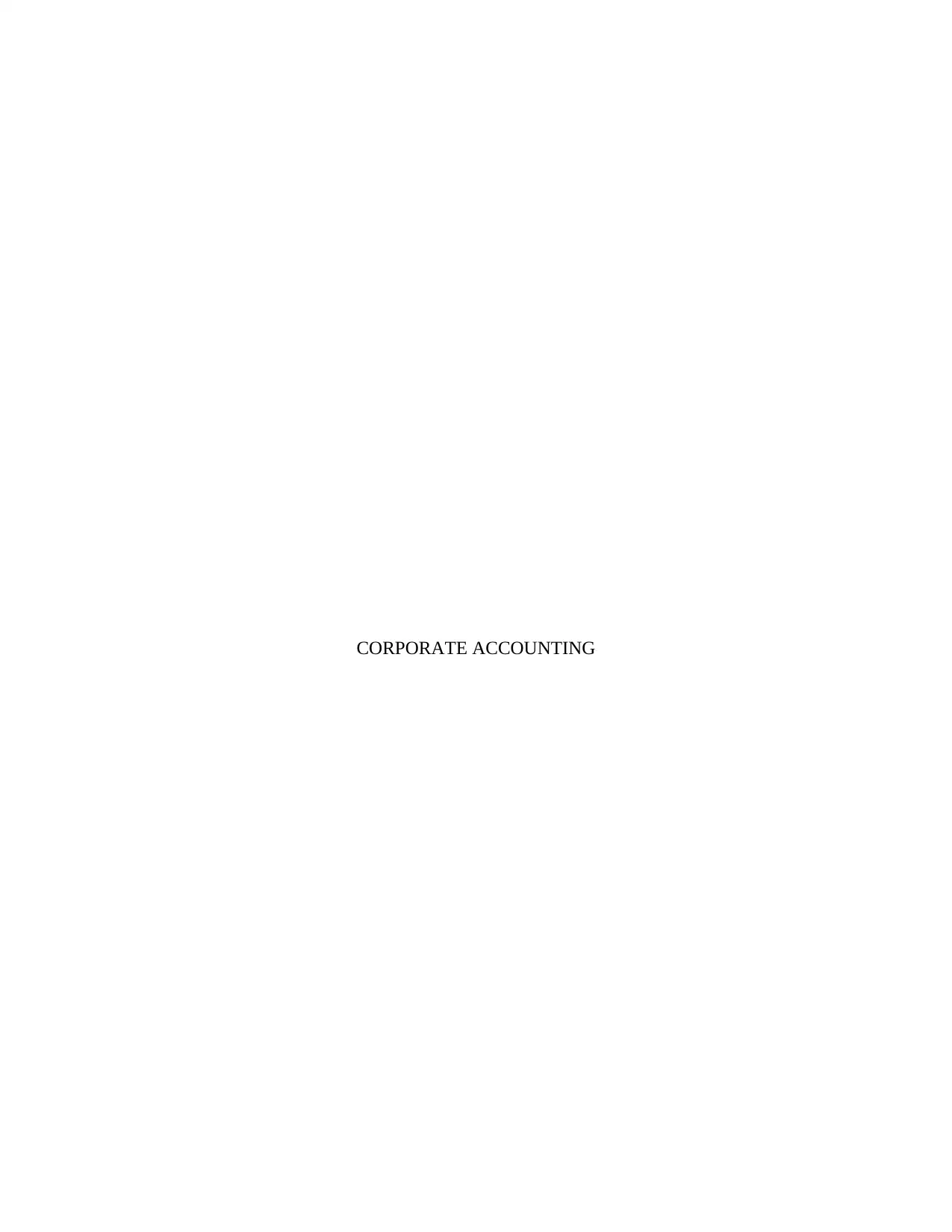
CORPORATE ACCOUNTING
Paraphrase This Document
Need a fresh take? Get an instant paraphrase of this document with our AI Paraphraser
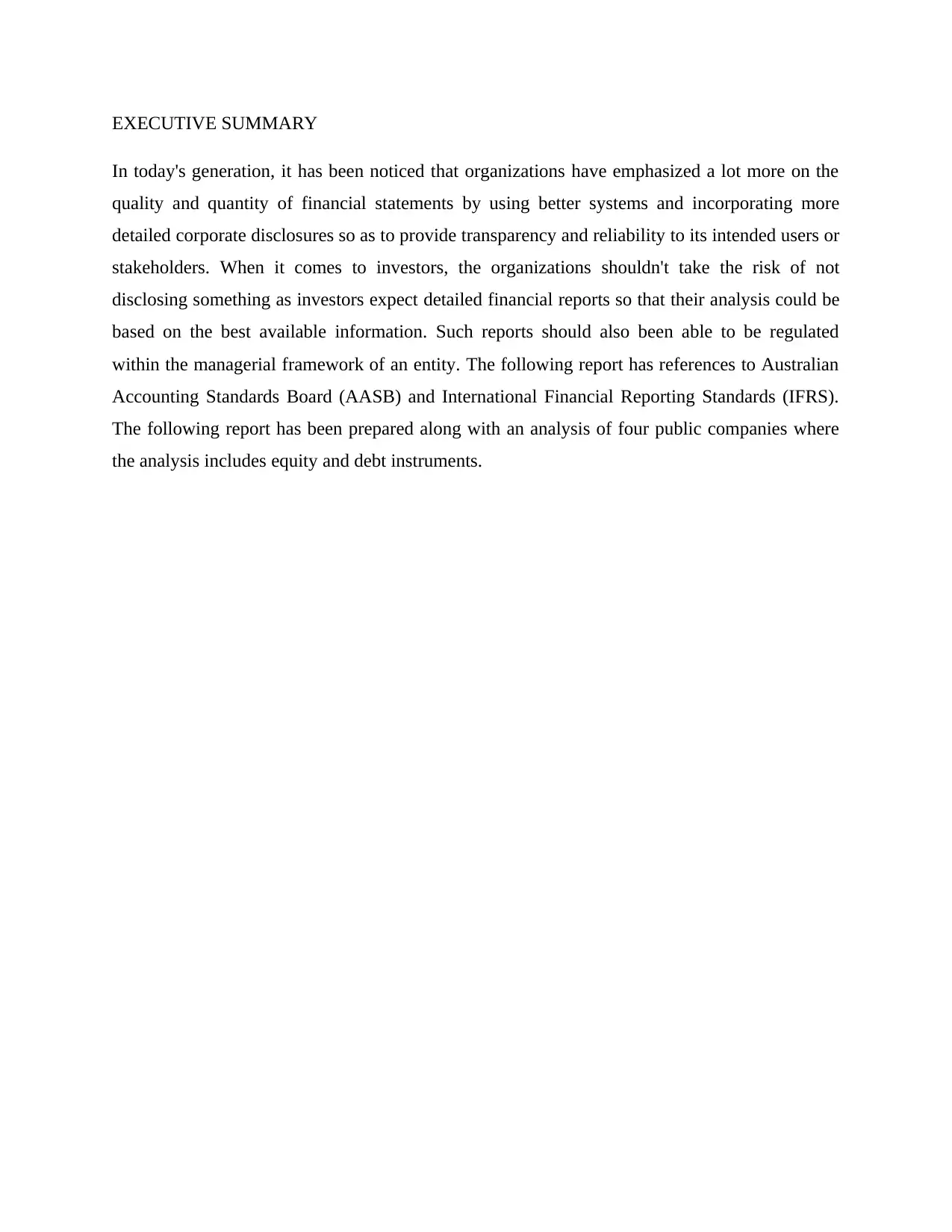
EXECUTIVE SUMMARY
In today's generation, it has been noticed that organizations have emphasized a lot more on the
quality and quantity of financial statements by using better systems and incorporating more
detailed corporate disclosures so as to provide transparency and reliability to its intended users or
stakeholders. When it comes to investors, the organizations shouldn't take the risk of not
disclosing something as investors expect detailed financial reports so that their analysis could be
based on the best available information. Such reports should also been able to be regulated
within the managerial framework of an entity. The following report has references to Australian
Accounting Standards Board (AASB) and International Financial Reporting Standards (IFRS).
The following report has been prepared along with an analysis of four public companies where
the analysis includes equity and debt instruments.
In today's generation, it has been noticed that organizations have emphasized a lot more on the
quality and quantity of financial statements by using better systems and incorporating more
detailed corporate disclosures so as to provide transparency and reliability to its intended users or
stakeholders. When it comes to investors, the organizations shouldn't take the risk of not
disclosing something as investors expect detailed financial reports so that their analysis could be
based on the best available information. Such reports should also been able to be regulated
within the managerial framework of an entity. The following report has references to Australian
Accounting Standards Board (AASB) and International Financial Reporting Standards (IFRS).
The following report has been prepared along with an analysis of four public companies where
the analysis includes equity and debt instruments.
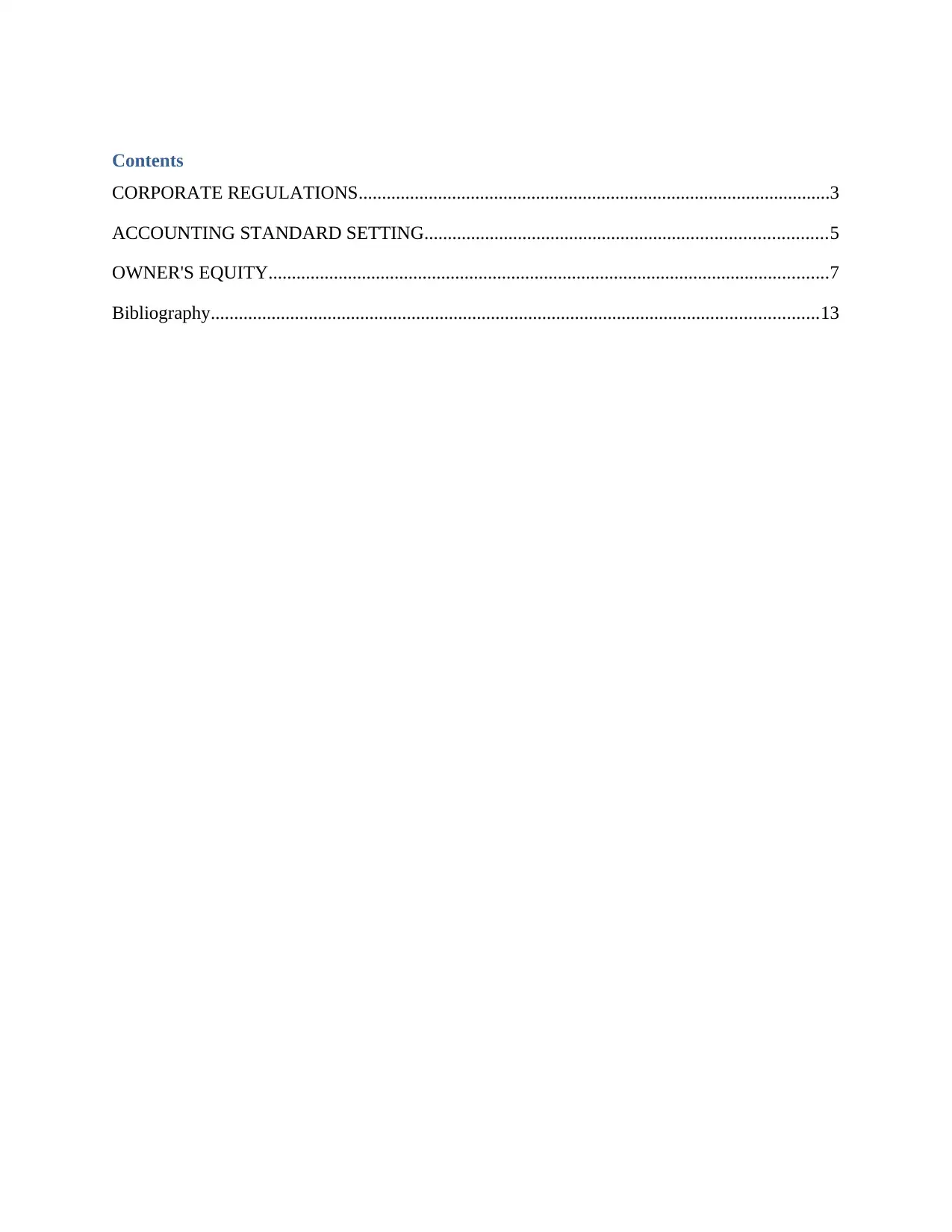
Contents
CORPORATE REGULATIONS.....................................................................................................3
ACCOUNTING STANDARD SETTING......................................................................................5
OWNER'S EQUITY........................................................................................................................7
Bibliography..................................................................................................................................13
CORPORATE REGULATIONS.....................................................................................................3
ACCOUNTING STANDARD SETTING......................................................................................5
OWNER'S EQUITY........................................................................................................................7
Bibliography..................................................................................................................................13
⊘ This is a preview!⊘
Do you want full access?
Subscribe today to unlock all pages.

Trusted by 1+ million students worldwide
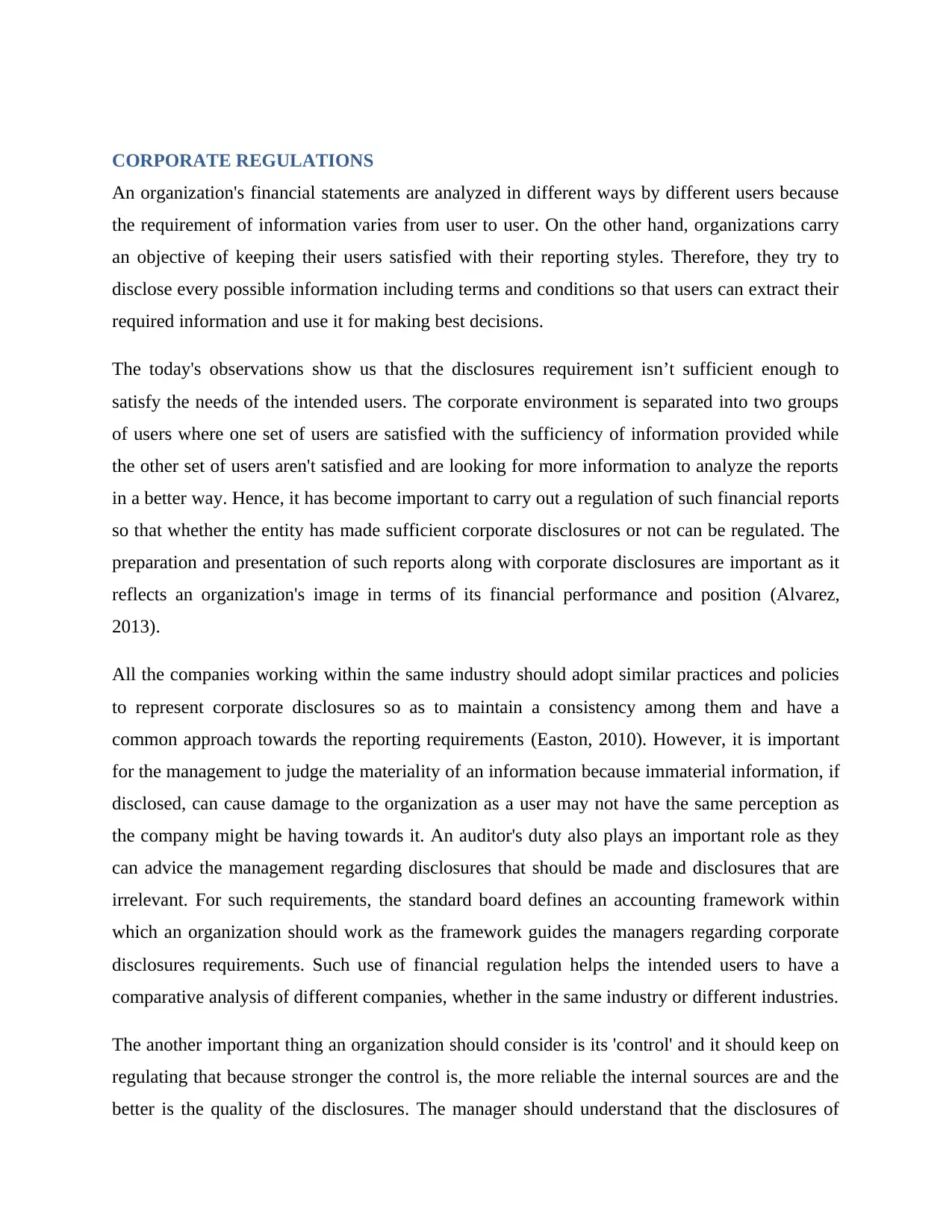
CORPORATE REGULATIONS
An organization's financial statements are analyzed in different ways by different users because
the requirement of information varies from user to user. On the other hand, organizations carry
an objective of keeping their users satisfied with their reporting styles. Therefore, they try to
disclose every possible information including terms and conditions so that users can extract their
required information and use it for making best decisions.
The today's observations show us that the disclosures requirement isn’t sufficient enough to
satisfy the needs of the intended users. The corporate environment is separated into two groups
of users where one set of users are satisfied with the sufficiency of information provided while
the other set of users aren't satisfied and are looking for more information to analyze the reports
in a better way. Hence, it has become important to carry out a regulation of such financial reports
so that whether the entity has made sufficient corporate disclosures or not can be regulated. The
preparation and presentation of such reports along with corporate disclosures are important as it
reflects an organization's image in terms of its financial performance and position (Alvarez,
2013).
All the companies working within the same industry should adopt similar practices and policies
to represent corporate disclosures so as to maintain a consistency among them and have a
common approach towards the reporting requirements (Easton, 2010). However, it is important
for the management to judge the materiality of an information because immaterial information, if
disclosed, can cause damage to the organization as a user may not have the same perception as
the company might be having towards it. An auditor's duty also plays an important role as they
can advice the management regarding disclosures that should be made and disclosures that are
irrelevant. For such requirements, the standard board defines an accounting framework within
which an organization should work as the framework guides the managers regarding corporate
disclosures requirements. Such use of financial regulation helps the intended users to have a
comparative analysis of different companies, whether in the same industry or different industries.
The another important thing an organization should consider is its 'control' and it should keep on
regulating that because stronger the control is, the more reliable the internal sources are and the
better is the quality of the disclosures. The manager should understand that the disclosures of
An organization's financial statements are analyzed in different ways by different users because
the requirement of information varies from user to user. On the other hand, organizations carry
an objective of keeping their users satisfied with their reporting styles. Therefore, they try to
disclose every possible information including terms and conditions so that users can extract their
required information and use it for making best decisions.
The today's observations show us that the disclosures requirement isn’t sufficient enough to
satisfy the needs of the intended users. The corporate environment is separated into two groups
of users where one set of users are satisfied with the sufficiency of information provided while
the other set of users aren't satisfied and are looking for more information to analyze the reports
in a better way. Hence, it has become important to carry out a regulation of such financial reports
so that whether the entity has made sufficient corporate disclosures or not can be regulated. The
preparation and presentation of such reports along with corporate disclosures are important as it
reflects an organization's image in terms of its financial performance and position (Alvarez,
2013).
All the companies working within the same industry should adopt similar practices and policies
to represent corporate disclosures so as to maintain a consistency among them and have a
common approach towards the reporting requirements (Easton, 2010). However, it is important
for the management to judge the materiality of an information because immaterial information, if
disclosed, can cause damage to the organization as a user may not have the same perception as
the company might be having towards it. An auditor's duty also plays an important role as they
can advice the management regarding disclosures that should be made and disclosures that are
irrelevant. For such requirements, the standard board defines an accounting framework within
which an organization should work as the framework guides the managers regarding corporate
disclosures requirements. Such use of financial regulation helps the intended users to have a
comparative analysis of different companies, whether in the same industry or different industries.
The another important thing an organization should consider is its 'control' and it should keep on
regulating that because stronger the control is, the more reliable the internal sources are and the
better is the quality of the disclosures. The manager should understand that the disclosures of
Paraphrase This Document
Need a fresh take? Get an instant paraphrase of this document with our AI Paraphraser
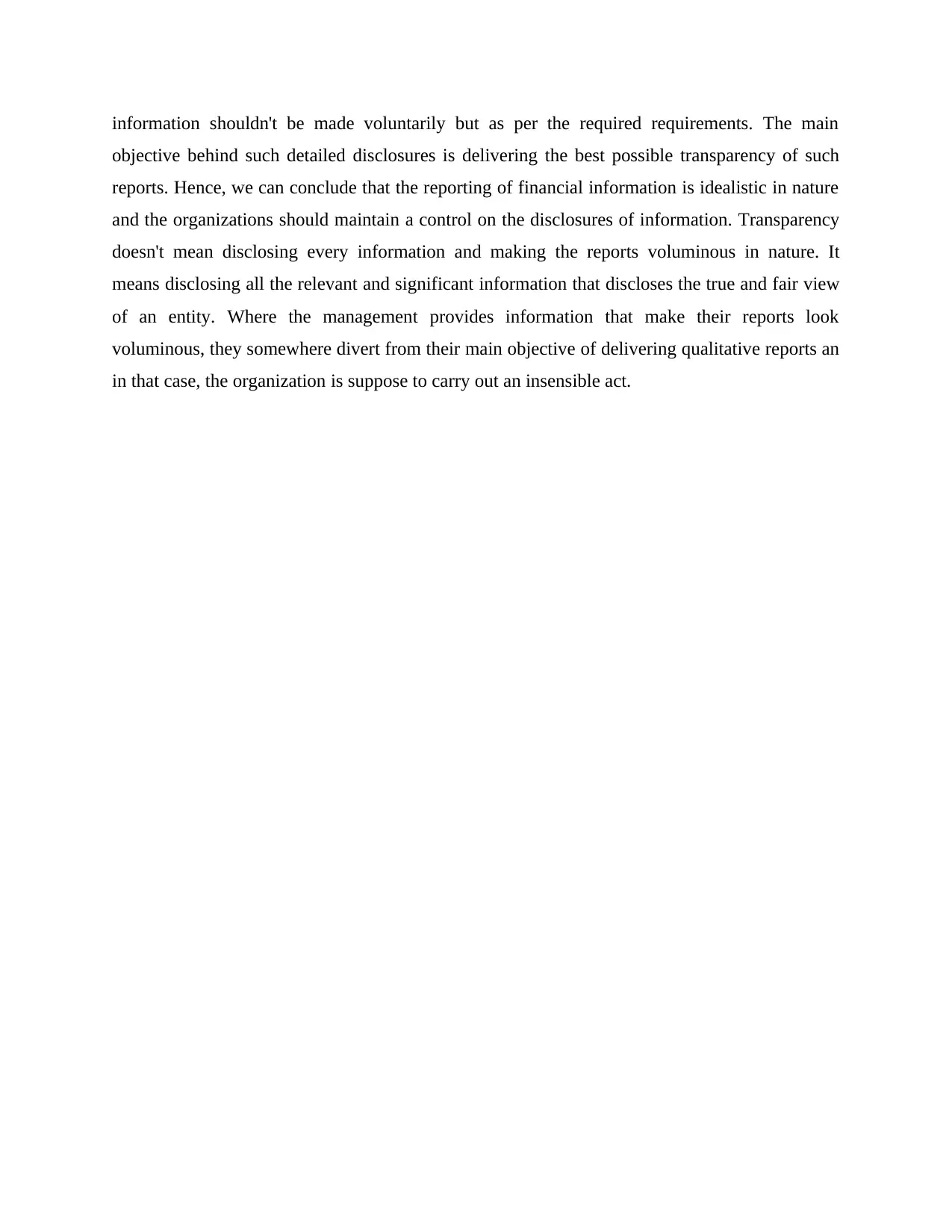
information shouldn't be made voluntarily but as per the required requirements. The main
objective behind such detailed disclosures is delivering the best possible transparency of such
reports. Hence, we can conclude that the reporting of financial information is idealistic in nature
and the organizations should maintain a control on the disclosures of information. Transparency
doesn't mean disclosing every information and making the reports voluminous in nature. It
means disclosing all the relevant and significant information that discloses the true and fair view
of an entity. Where the management provides information that make their reports look
voluminous, they somewhere divert from their main objective of delivering qualitative reports an
in that case, the organization is suppose to carry out an insensible act.
objective behind such detailed disclosures is delivering the best possible transparency of such
reports. Hence, we can conclude that the reporting of financial information is idealistic in nature
and the organizations should maintain a control on the disclosures of information. Transparency
doesn't mean disclosing every information and making the reports voluminous in nature. It
means disclosing all the relevant and significant information that discloses the true and fair view
of an entity. Where the management provides information that make their reports look
voluminous, they somewhere divert from their main objective of delivering qualitative reports an
in that case, the organization is suppose to carry out an insensible act.
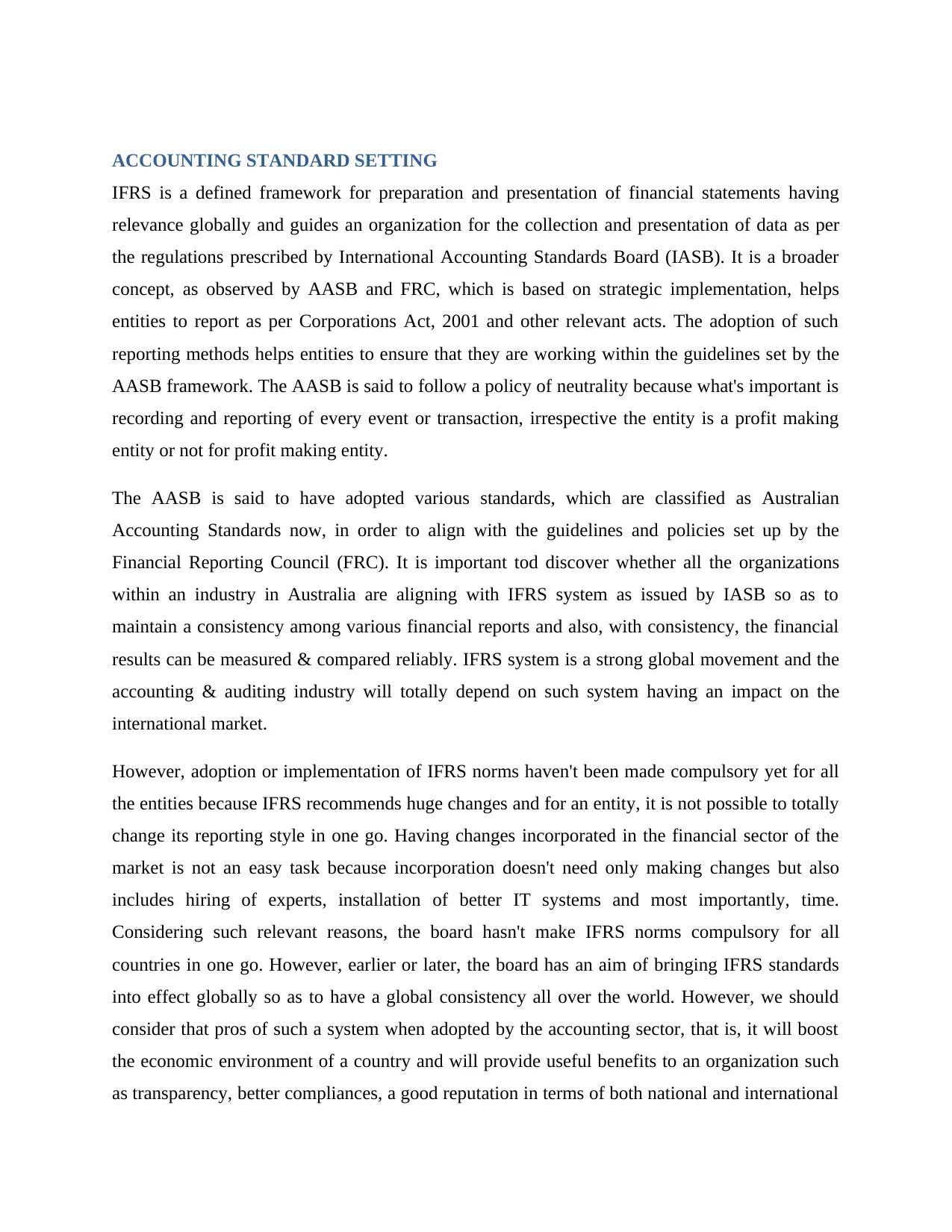
ACCOUNTING STANDARD SETTING
IFRS is a defined framework for preparation and presentation of financial statements having
relevance globally and guides an organization for the collection and presentation of data as per
the regulations prescribed by International Accounting Standards Board (IASB). It is a broader
concept, as observed by AASB and FRC, which is based on strategic implementation, helps
entities to report as per Corporations Act, 2001 and other relevant acts. The adoption of such
reporting methods helps entities to ensure that they are working within the guidelines set by the
AASB framework. The AASB is said to follow a policy of neutrality because what's important is
recording and reporting of every event or transaction, irrespective the entity is a profit making
entity or not for profit making entity.
The AASB is said to have adopted various standards, which are classified as Australian
Accounting Standards now, in order to align with the guidelines and policies set up by the
Financial Reporting Council (FRC). It is important tod discover whether all the organizations
within an industry in Australia are aligning with IFRS system as issued by IASB so as to
maintain a consistency among various financial reports and also, with consistency, the financial
results can be measured & compared reliably. IFRS system is a strong global movement and the
accounting & auditing industry will totally depend on such system having an impact on the
international market.
However, adoption or implementation of IFRS norms haven't been made compulsory yet for all
the entities because IFRS recommends huge changes and for an entity, it is not possible to totally
change its reporting style in one go. Having changes incorporated in the financial sector of the
market is not an easy task because incorporation doesn't need only making changes but also
includes hiring of experts, installation of better IT systems and most importantly, time.
Considering such relevant reasons, the board hasn't make IFRS norms compulsory for all
countries in one go. However, earlier or later, the board has an aim of bringing IFRS standards
into effect globally so as to have a global consistency all over the world. However, we should
consider that pros of such a system when adopted by the accounting sector, that is, it will boost
the economic environment of a country and will provide useful benefits to an organization such
as transparency, better compliances, a good reputation in terms of both national and international
IFRS is a defined framework for preparation and presentation of financial statements having
relevance globally and guides an organization for the collection and presentation of data as per
the regulations prescribed by International Accounting Standards Board (IASB). It is a broader
concept, as observed by AASB and FRC, which is based on strategic implementation, helps
entities to report as per Corporations Act, 2001 and other relevant acts. The adoption of such
reporting methods helps entities to ensure that they are working within the guidelines set by the
AASB framework. The AASB is said to follow a policy of neutrality because what's important is
recording and reporting of every event or transaction, irrespective the entity is a profit making
entity or not for profit making entity.
The AASB is said to have adopted various standards, which are classified as Australian
Accounting Standards now, in order to align with the guidelines and policies set up by the
Financial Reporting Council (FRC). It is important tod discover whether all the organizations
within an industry in Australia are aligning with IFRS system as issued by IASB so as to
maintain a consistency among various financial reports and also, with consistency, the financial
results can be measured & compared reliably. IFRS system is a strong global movement and the
accounting & auditing industry will totally depend on such system having an impact on the
international market.
However, adoption or implementation of IFRS norms haven't been made compulsory yet for all
the entities because IFRS recommends huge changes and for an entity, it is not possible to totally
change its reporting style in one go. Having changes incorporated in the financial sector of the
market is not an easy task because incorporation doesn't need only making changes but also
includes hiring of experts, installation of better IT systems and most importantly, time.
Considering such relevant reasons, the board hasn't make IFRS norms compulsory for all
countries in one go. However, earlier or later, the board has an aim of bringing IFRS standards
into effect globally so as to have a global consistency all over the world. However, we should
consider that pros of such a system when adopted by the accounting sector, that is, it will boost
the economic environment of a country and will provide useful benefits to an organization such
as transparency, better compliances, a good reputation in terms of both national and international
⊘ This is a preview!⊘
Do you want full access?
Subscribe today to unlock all pages.

Trusted by 1+ million students worldwide
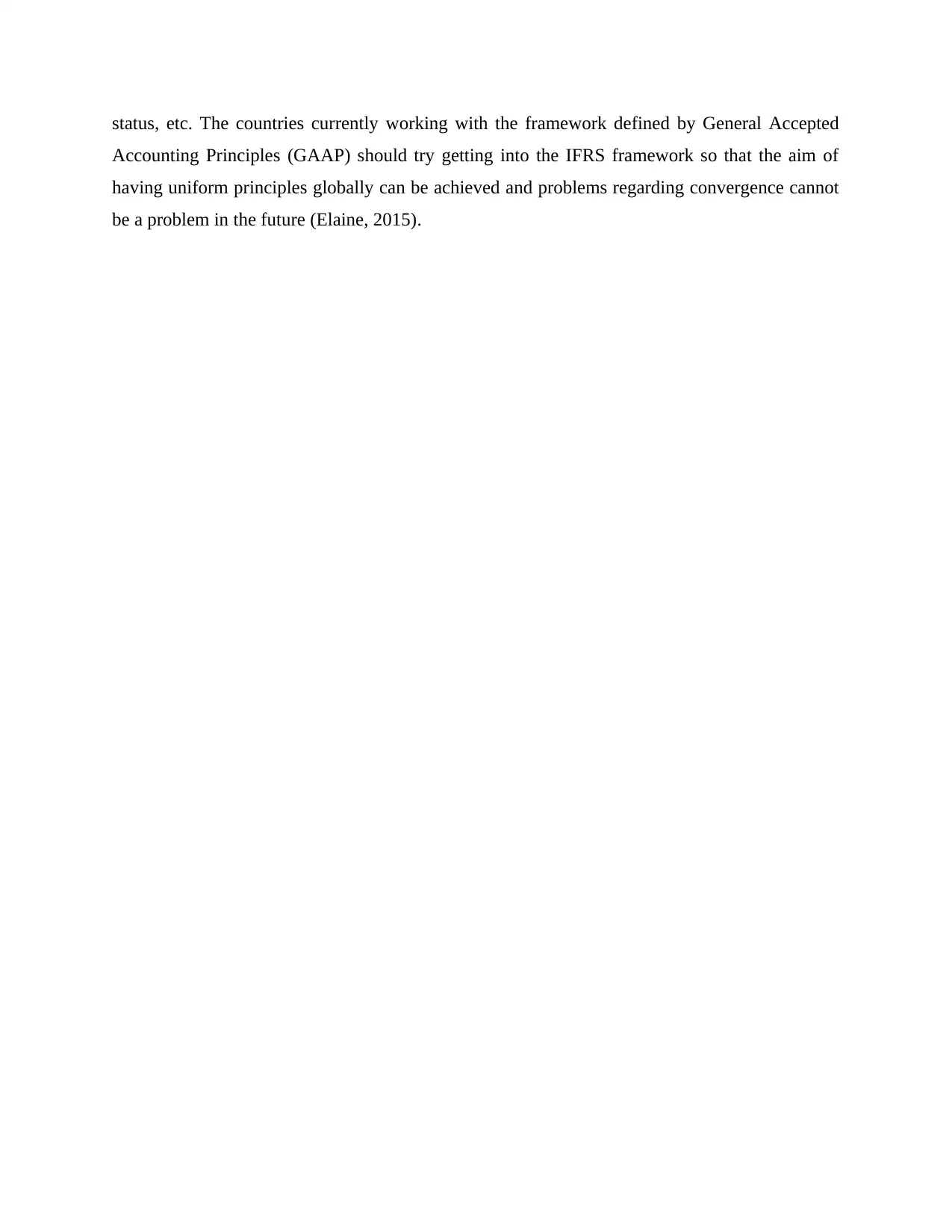
status, etc. The countries currently working with the framework defined by General Accepted
Accounting Principles (GAAP) should try getting into the IFRS framework so that the aim of
having uniform principles globally can be achieved and problems regarding convergence cannot
be a problem in the future (Elaine, 2015).
Accounting Principles (GAAP) should try getting into the IFRS framework so that the aim of
having uniform principles globally can be achieved and problems regarding convergence cannot
be a problem in the future (Elaine, 2015).
Paraphrase This Document
Need a fresh take? Get an instant paraphrase of this document with our AI Paraphraser
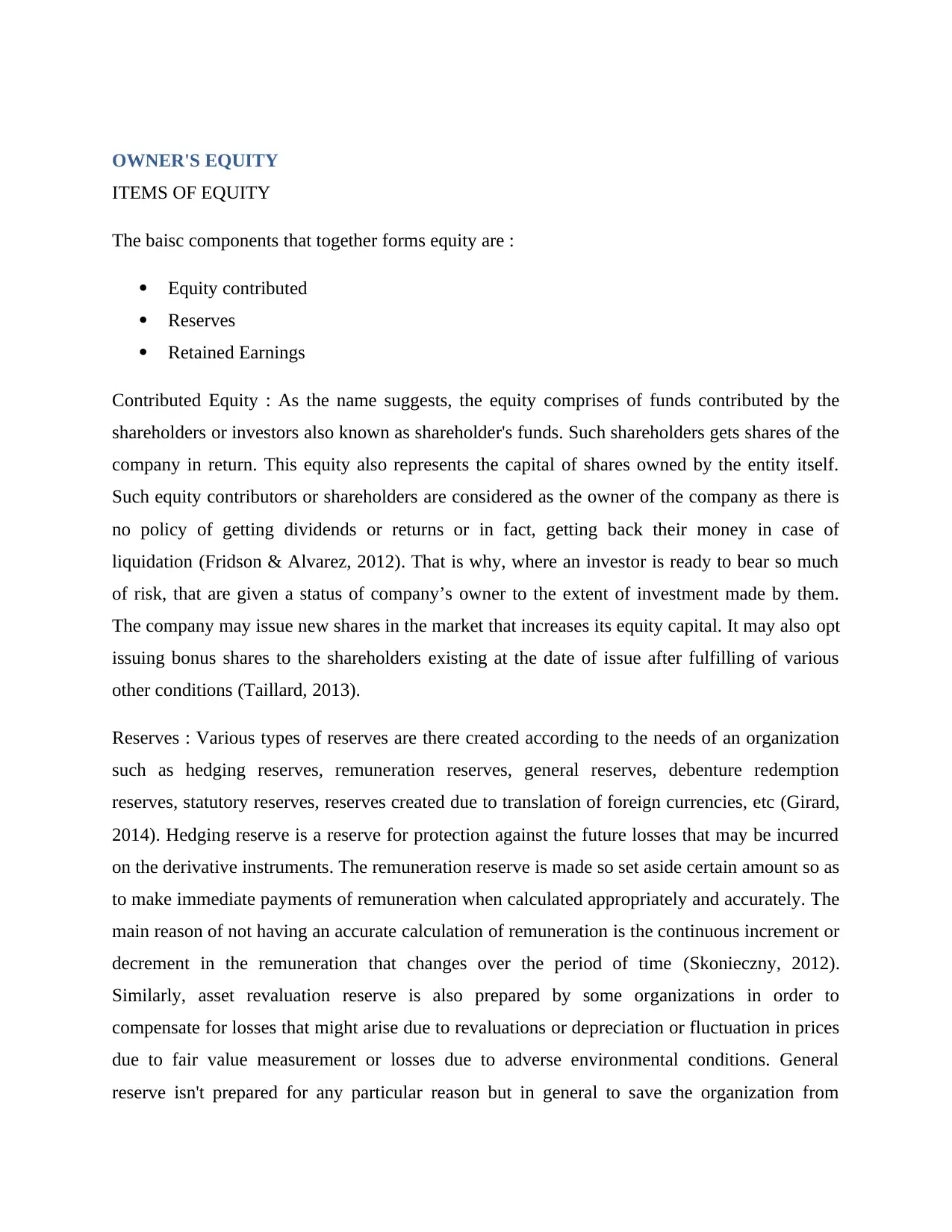
OWNER'S EQUITY
ITEMS OF EQUITY
The baisc components that together forms equity are :
Equity contributed
Reserves
Retained Earnings
Contributed Equity : As the name suggests, the equity comprises of funds contributed by the
shareholders or investors also known as shareholder's funds. Such shareholders gets shares of the
company in return. This equity also represents the capital of shares owned by the entity itself.
Such equity contributors or shareholders are considered as the owner of the company as there is
no policy of getting dividends or returns or in fact, getting back their money in case of
liquidation (Fridson & Alvarez, 2012). That is why, where an investor is ready to bear so much
of risk, that are given a status of company’s owner to the extent of investment made by them.
The company may issue new shares in the market that increases its equity capital. It may also opt
issuing bonus shares to the shareholders existing at the date of issue after fulfilling of various
other conditions (Taillard, 2013).
Reserves : Various types of reserves are there created according to the needs of an organization
such as hedging reserves, remuneration reserves, general reserves, debenture redemption
reserves, statutory reserves, reserves created due to translation of foreign currencies, etc (Girard,
2014). Hedging reserve is a reserve for protection against the future losses that may be incurred
on the derivative instruments. The remuneration reserve is made so set aside certain amount so as
to make immediate payments of remuneration when calculated appropriately and accurately. The
main reason of not having an accurate calculation of remuneration is the continuous increment or
decrement in the remuneration that changes over the period of time (Skonieczny, 2012).
Similarly, asset revaluation reserve is also prepared by some organizations in order to
compensate for losses that might arise due to revaluations or depreciation or fluctuation in prices
due to fair value measurement or losses due to adverse environmental conditions. General
reserve isn't prepared for any particular reason but in general to save the organization from
ITEMS OF EQUITY
The baisc components that together forms equity are :
Equity contributed
Reserves
Retained Earnings
Contributed Equity : As the name suggests, the equity comprises of funds contributed by the
shareholders or investors also known as shareholder's funds. Such shareholders gets shares of the
company in return. This equity also represents the capital of shares owned by the entity itself.
Such equity contributors or shareholders are considered as the owner of the company as there is
no policy of getting dividends or returns or in fact, getting back their money in case of
liquidation (Fridson & Alvarez, 2012). That is why, where an investor is ready to bear so much
of risk, that are given a status of company’s owner to the extent of investment made by them.
The company may issue new shares in the market that increases its equity capital. It may also opt
issuing bonus shares to the shareholders existing at the date of issue after fulfilling of various
other conditions (Taillard, 2013).
Reserves : Various types of reserves are there created according to the needs of an organization
such as hedging reserves, remuneration reserves, general reserves, debenture redemption
reserves, statutory reserves, reserves created due to translation of foreign currencies, etc (Girard,
2014). Hedging reserve is a reserve for protection against the future losses that may be incurred
on the derivative instruments. The remuneration reserve is made so set aside certain amount so as
to make immediate payments of remuneration when calculated appropriately and accurately. The
main reason of not having an accurate calculation of remuneration is the continuous increment or
decrement in the remuneration that changes over the period of time (Skonieczny, 2012).
Similarly, asset revaluation reserve is also prepared by some organizations in order to
compensate for losses that might arise due to revaluations or depreciation or fluctuation in prices
due to fair value measurement or losses due to adverse environmental conditions. General
reserve isn't prepared for any particular reason but in general to save the organization from
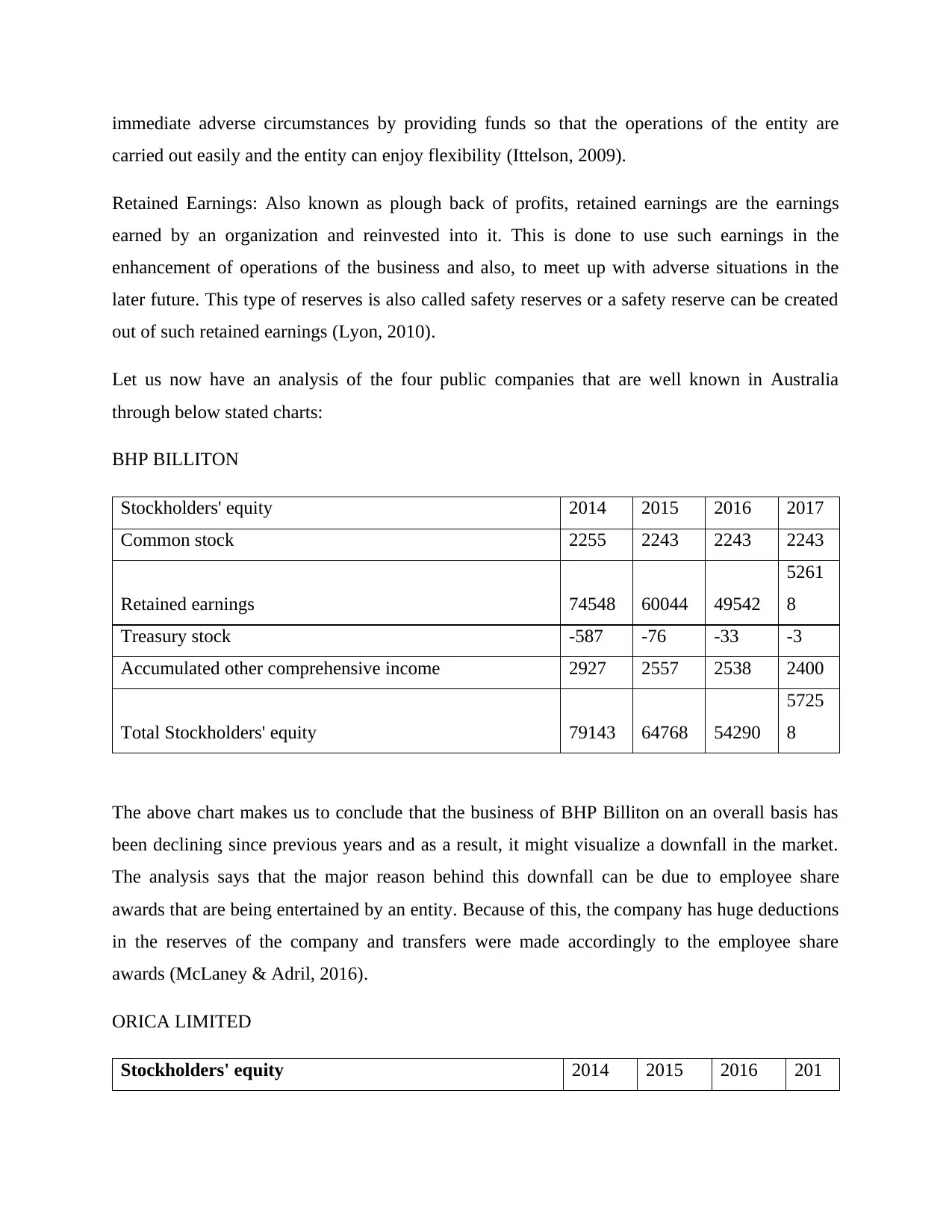
immediate adverse circumstances by providing funds so that the operations of the entity are
carried out easily and the entity can enjoy flexibility (Ittelson, 2009).
Retained Earnings: Also known as plough back of profits, retained earnings are the earnings
earned by an organization and reinvested into it. This is done to use such earnings in the
enhancement of operations of the business and also, to meet up with adverse situations in the
later future. This type of reserves is also called safety reserves or a safety reserve can be created
out of such retained earnings (Lyon, 2010).
Let us now have an analysis of the four public companies that are well known in Australia
through below stated charts:
BHP BILLITON
Stockholders' equity 2014 2015 2016 2017
Common stock 2255 2243 2243 2243
Retained earnings 74548 60044 49542
5261
8
Treasury stock -587 -76 -33 -3
Accumulated other comprehensive income 2927 2557 2538 2400
Total Stockholders' equity 79143 64768 54290
5725
8
The above chart makes us to conclude that the business of BHP Billiton on an overall basis has
been declining since previous years and as a result, it might visualize a downfall in the market.
The analysis says that the major reason behind this downfall can be due to employee share
awards that are being entertained by an entity. Because of this, the company has huge deductions
in the reserves of the company and transfers were made accordingly to the employee share
awards (McLaney & Adril, 2016).
ORICA LIMITED
Stockholders' equity 2014 2015 2016 201
carried out easily and the entity can enjoy flexibility (Ittelson, 2009).
Retained Earnings: Also known as plough back of profits, retained earnings are the earnings
earned by an organization and reinvested into it. This is done to use such earnings in the
enhancement of operations of the business and also, to meet up with adverse situations in the
later future. This type of reserves is also called safety reserves or a safety reserve can be created
out of such retained earnings (Lyon, 2010).
Let us now have an analysis of the four public companies that are well known in Australia
through below stated charts:
BHP BILLITON
Stockholders' equity 2014 2015 2016 2017
Common stock 2255 2243 2243 2243
Retained earnings 74548 60044 49542
5261
8
Treasury stock -587 -76 -33 -3
Accumulated other comprehensive income 2927 2557 2538 2400
Total Stockholders' equity 79143 64768 54290
5725
8
The above chart makes us to conclude that the business of BHP Billiton on an overall basis has
been declining since previous years and as a result, it might visualize a downfall in the market.
The analysis says that the major reason behind this downfall can be due to employee share
awards that are being entertained by an entity. Because of this, the company has huge deductions
in the reserves of the company and transfers were made accordingly to the employee share
awards (McLaney & Adril, 2016).
ORICA LIMITED
Stockholders' equity 2014 2015 2016 201
⊘ This is a preview!⊘
Do you want full access?
Subscribe today to unlock all pages.

Trusted by 1+ million students worldwide
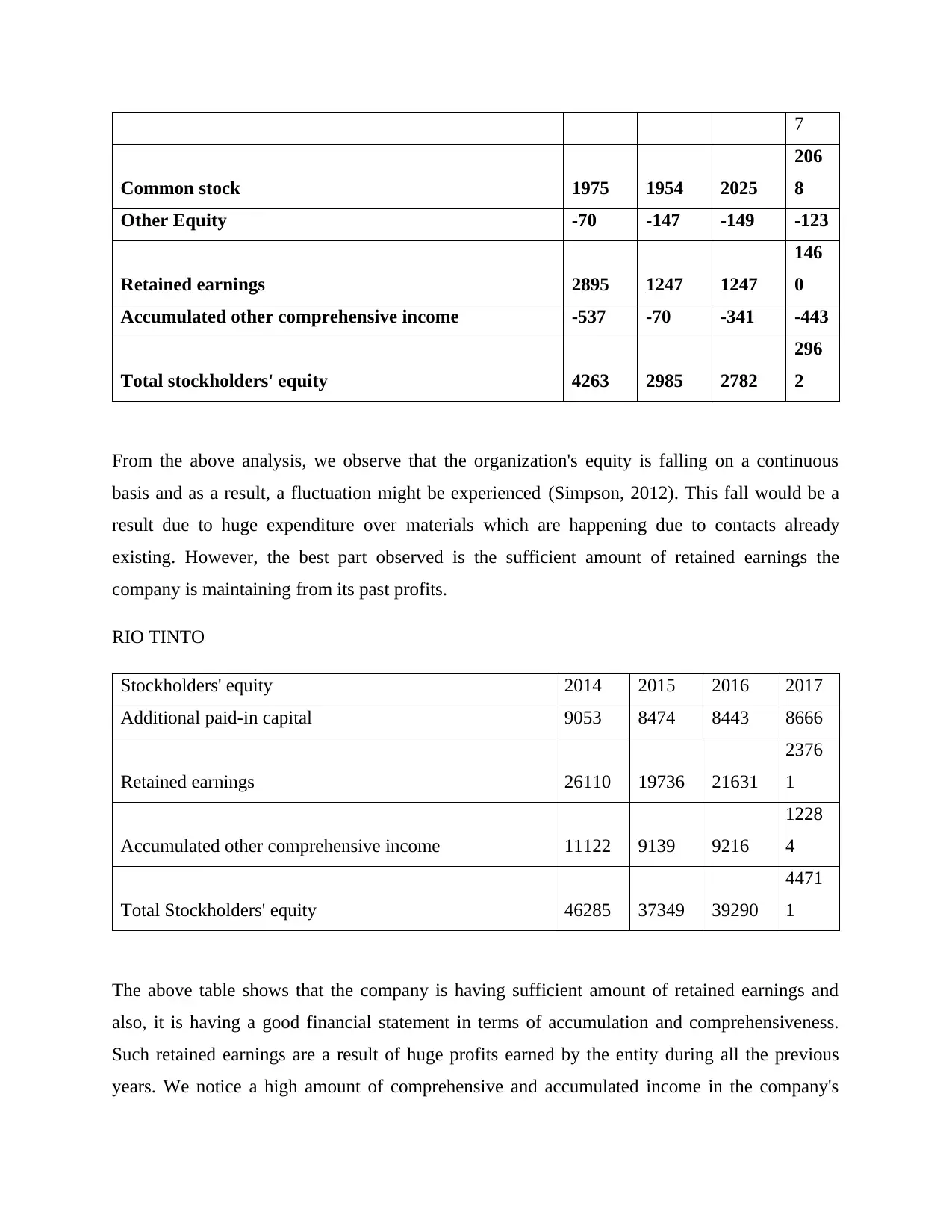
7
Common stock 1975 1954 2025
206
8
Other Equity -70 -147 -149 -123
Retained earnings 2895 1247 1247
146
0
Accumulated other comprehensive income -537 -70 -341 -443
Total stockholders' equity 4263 2985 2782
296
2
From the above analysis, we observe that the organization's equity is falling on a continuous
basis and as a result, a fluctuation might be experienced (Simpson, 2012). This fall would be a
result due to huge expenditure over materials which are happening due to contacts already
existing. However, the best part observed is the sufficient amount of retained earnings the
company is maintaining from its past profits.
RIO TINTO
Stockholders' equity 2014 2015 2016 2017
Additional paid-in capital 9053 8474 8443 8666
Retained earnings 26110 19736 21631
2376
1
Accumulated other comprehensive income 11122 9139 9216
1228
4
Total Stockholders' equity 46285 37349 39290
4471
1
The above table shows that the company is having sufficient amount of retained earnings and
also, it is having a good financial statement in terms of accumulation and comprehensiveness.
Such retained earnings are a result of huge profits earned by the entity during all the previous
years. We notice a high amount of comprehensive and accumulated income in the company's
Common stock 1975 1954 2025
206
8
Other Equity -70 -147 -149 -123
Retained earnings 2895 1247 1247
146
0
Accumulated other comprehensive income -537 -70 -341 -443
Total stockholders' equity 4263 2985 2782
296
2
From the above analysis, we observe that the organization's equity is falling on a continuous
basis and as a result, a fluctuation might be experienced (Simpson, 2012). This fall would be a
result due to huge expenditure over materials which are happening due to contacts already
existing. However, the best part observed is the sufficient amount of retained earnings the
company is maintaining from its past profits.
RIO TINTO
Stockholders' equity 2014 2015 2016 2017
Additional paid-in capital 9053 8474 8443 8666
Retained earnings 26110 19736 21631
2376
1
Accumulated other comprehensive income 11122 9139 9216
1228
4
Total Stockholders' equity 46285 37349 39290
4471
1
The above table shows that the company is having sufficient amount of retained earnings and
also, it is having a good financial statement in terms of accumulation and comprehensiveness.
Such retained earnings are a result of huge profits earned by the entity during all the previous
years. We notice a high amount of comprehensive and accumulated income in the company's
Paraphrase This Document
Need a fresh take? Get an instant paraphrase of this document with our AI Paraphraser
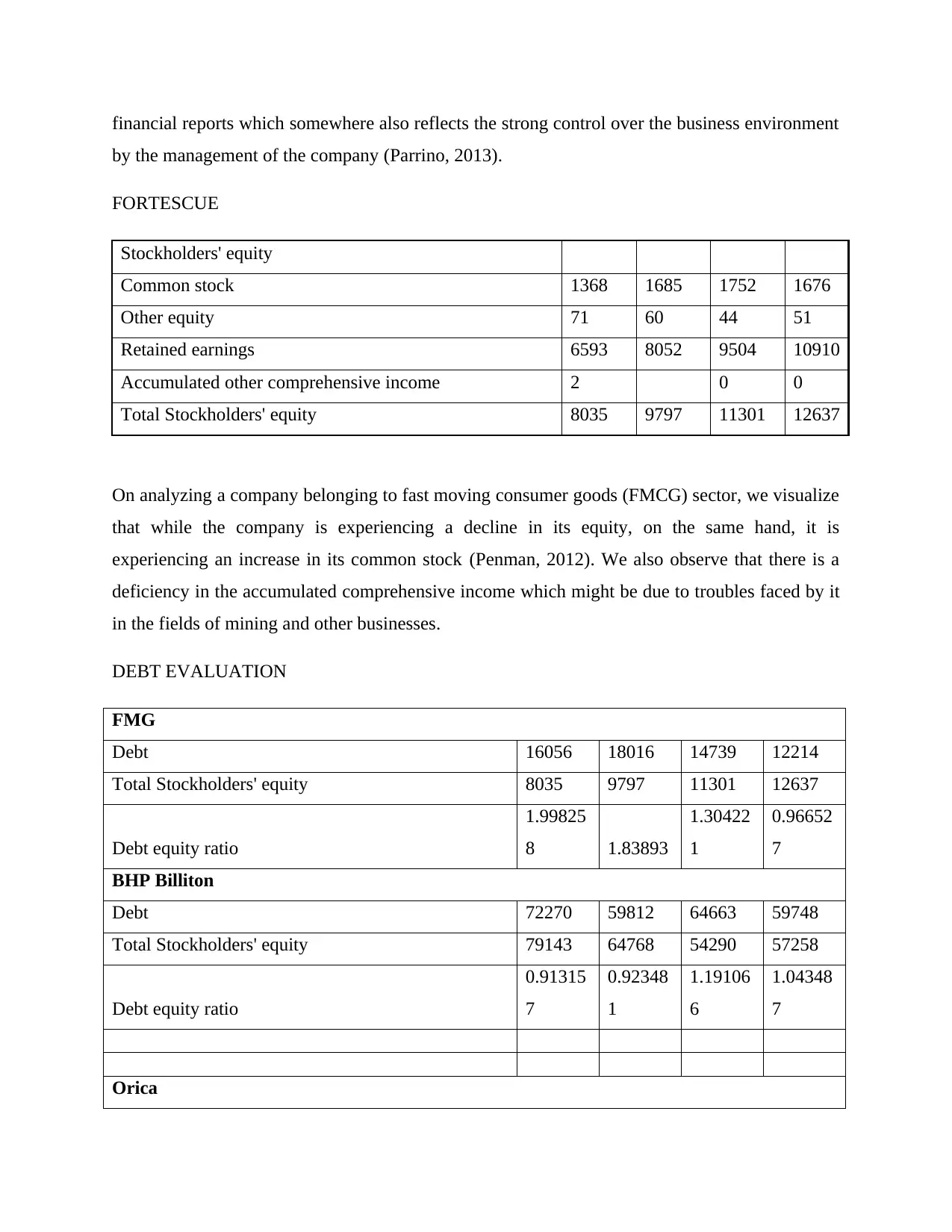
financial reports which somewhere also reflects the strong control over the business environment
by the management of the company (Parrino, 2013).
FORTESCUE
Stockholders' equity
Common stock 1368 1685 1752 1676
Other equity 71 60 44 51
Retained earnings 6593 8052 9504 10910
Accumulated other comprehensive income 2 0 0
Total Stockholders' equity 8035 9797 11301 12637
On analyzing a company belonging to fast moving consumer goods (FMCG) sector, we visualize
that while the company is experiencing a decline in its equity, on the same hand, it is
experiencing an increase in its common stock (Penman, 2012). We also observe that there is a
deficiency in the accumulated comprehensive income which might be due to troubles faced by it
in the fields of mining and other businesses.
DEBT EVALUATION
FMG
Debt 16056 18016 14739 12214
Total Stockholders' equity 8035 9797 11301 12637
Debt equity ratio
1.99825
8 1.83893
1.30422
1
0.96652
7
BHP Billiton
Debt 72270 59812 64663 59748
Total Stockholders' equity 79143 64768 54290 57258
Debt equity ratio
0.91315
7
0.92348
1
1.19106
6
1.04348
7
Orica
by the management of the company (Parrino, 2013).
FORTESCUE
Stockholders' equity
Common stock 1368 1685 1752 1676
Other equity 71 60 44 51
Retained earnings 6593 8052 9504 10910
Accumulated other comprehensive income 2 0 0
Total Stockholders' equity 8035 9797 11301 12637
On analyzing a company belonging to fast moving consumer goods (FMCG) sector, we visualize
that while the company is experiencing a decline in its equity, on the same hand, it is
experiencing an increase in its common stock (Penman, 2012). We also observe that there is a
deficiency in the accumulated comprehensive income which might be due to troubles faced by it
in the fields of mining and other businesses.
DEBT EVALUATION
FMG
Debt 16056 18016 14739 12214
Total Stockholders' equity 8035 9797 11301 12637
Debt equity ratio
1.99825
8 1.83893
1.30422
1
0.96652
7
BHP Billiton
Debt 72270 59812 64663 59748
Total Stockholders' equity 79143 64768 54290 57258
Debt equity ratio
0.91315
7
0.92348
1
1.19106
6
1.04348
7
Orica
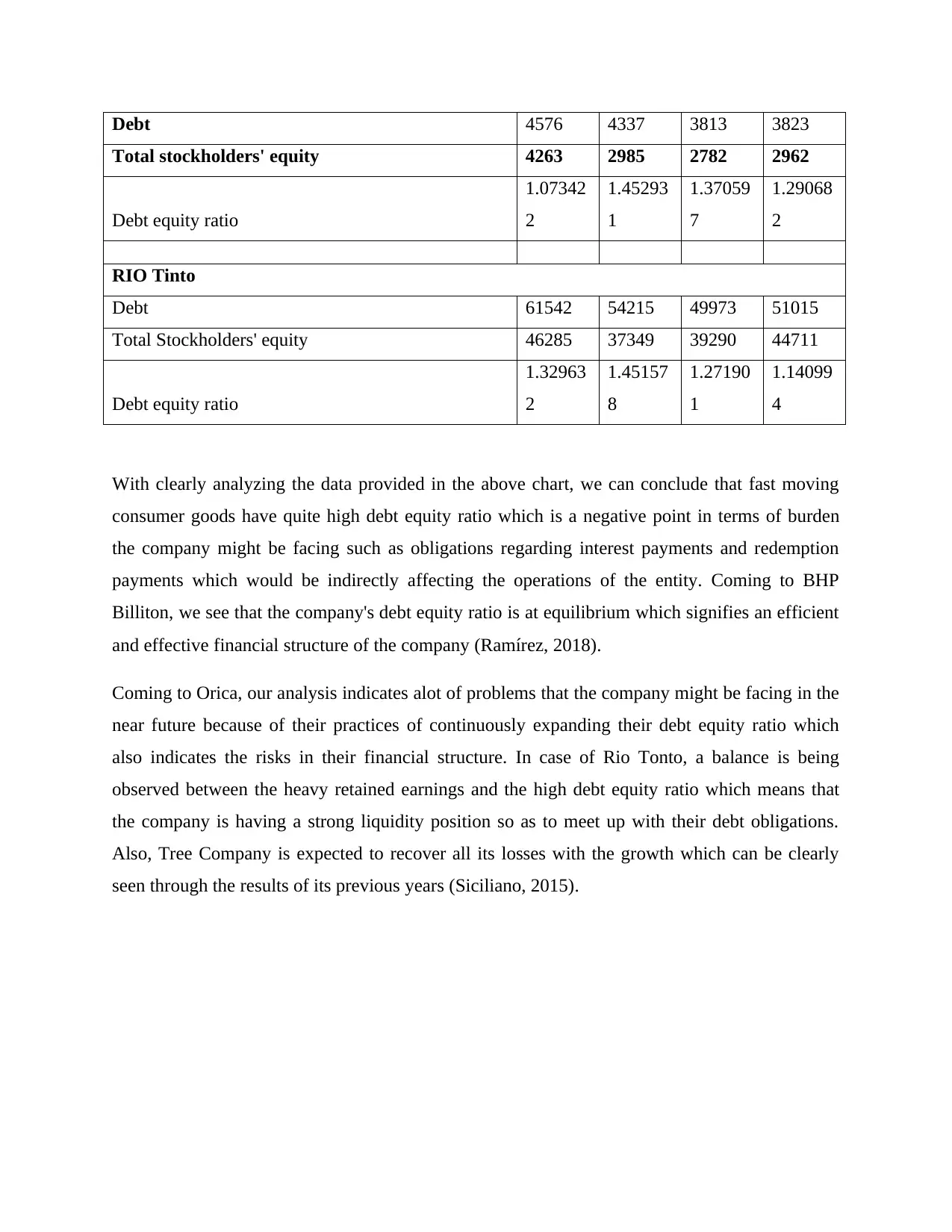
Debt 4576 4337 3813 3823
Total stockholders' equity 4263 2985 2782 2962
Debt equity ratio
1.07342
2
1.45293
1
1.37059
7
1.29068
2
RIO Tinto
Debt 61542 54215 49973 51015
Total Stockholders' equity 46285 37349 39290 44711
Debt equity ratio
1.32963
2
1.45157
8
1.27190
1
1.14099
4
With clearly analyzing the data provided in the above chart, we can conclude that fast moving
consumer goods have quite high debt equity ratio which is a negative point in terms of burden
the company might be facing such as obligations regarding interest payments and redemption
payments which would be indirectly affecting the operations of the entity. Coming to BHP
Billiton, we see that the company's debt equity ratio is at equilibrium which signifies an efficient
and effective financial structure of the company (Ramírez, 2018).
Coming to Orica, our analysis indicates alot of problems that the company might be facing in the
near future because of their practices of continuously expanding their debt equity ratio which
also indicates the risks in their financial structure. In case of Rio Tonto, a balance is being
observed between the heavy retained earnings and the high debt equity ratio which means that
the company is having a strong liquidity position so as to meet up with their debt obligations.
Also, Tree Company is expected to recover all its losses with the growth which can be clearly
seen through the results of its previous years (Siciliano, 2015).
Total stockholders' equity 4263 2985 2782 2962
Debt equity ratio
1.07342
2
1.45293
1
1.37059
7
1.29068
2
RIO Tinto
Debt 61542 54215 49973 51015
Total Stockholders' equity 46285 37349 39290 44711
Debt equity ratio
1.32963
2
1.45157
8
1.27190
1
1.14099
4
With clearly analyzing the data provided in the above chart, we can conclude that fast moving
consumer goods have quite high debt equity ratio which is a negative point in terms of burden
the company might be facing such as obligations regarding interest payments and redemption
payments which would be indirectly affecting the operations of the entity. Coming to BHP
Billiton, we see that the company's debt equity ratio is at equilibrium which signifies an efficient
and effective financial structure of the company (Ramírez, 2018).
Coming to Orica, our analysis indicates alot of problems that the company might be facing in the
near future because of their practices of continuously expanding their debt equity ratio which
also indicates the risks in their financial structure. In case of Rio Tonto, a balance is being
observed between the heavy retained earnings and the high debt equity ratio which means that
the company is having a strong liquidity position so as to meet up with their debt obligations.
Also, Tree Company is expected to recover all its losses with the growth which can be clearly
seen through the results of its previous years (Siciliano, 2015).
⊘ This is a preview!⊘
Do you want full access?
Subscribe today to unlock all pages.

Trusted by 1+ million students worldwide
1 out of 15
Related Documents
Your All-in-One AI-Powered Toolkit for Academic Success.
+13062052269
info@desklib.com
Available 24*7 on WhatsApp / Email
![[object Object]](/_next/static/media/star-bottom.7253800d.svg)
Unlock your academic potential
Copyright © 2020–2025 A2Z Services. All Rights Reserved. Developed and managed by ZUCOL.




